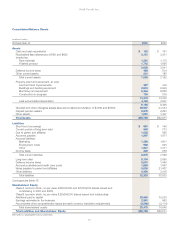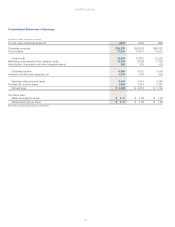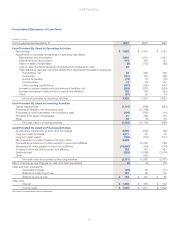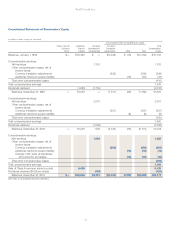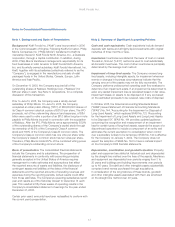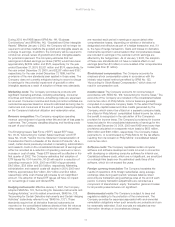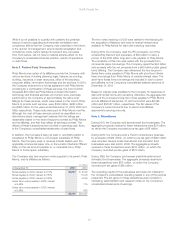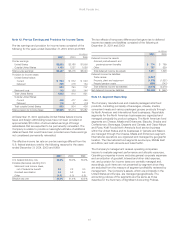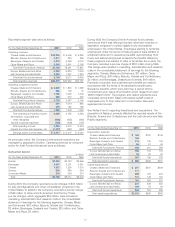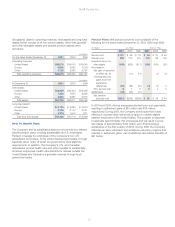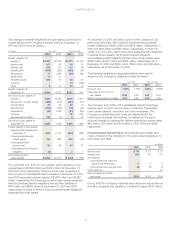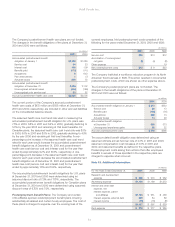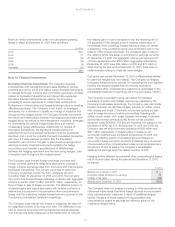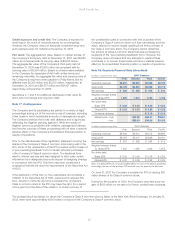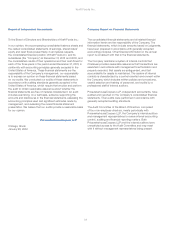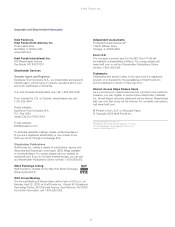Kraft 2001 Annual Report Download - page 55
Download and view the complete annual report
Please find page 55 of the 2001 Kraft annual report below. You can navigate through the pages in the report by either clicking on the pages listed below, or by using the keyword search tool below to find specific information within the annual report.
Kraft Foods Inc.
49
Note 12. Pre-tax Earnings and Provision for Income Taxes:
Pre-tax earnings and provision for income taxes consisted of the
following for the years ended December 31, 2001, 2000 and 1999:
(in millions)
2001 2000 1999
Pre-tax earnings:
United States $2,282 $2,188 $1,990
Outside United States 1,165 1,227 1,050
Total pre-tax earnings $3,447 $3,415 $3,040
Provision for income taxes:
United States federal:
Current $ 594 $ 572 $ 543
Deferred 299 218 164
893 790 707
State and local 112 120 144
Total United States 1,005 910 851
Outside United States:
Current 445 477 449
Deferred 115 27 (13)
Total outside United States 560 504 436
Total provision for income taxes $1,565 $1,414 $1,287
At December 31, 2001, applicable United States federal income
taxes and foreign withholding taxes have not been provided on
approximately $1.5 billion of accumulated earnings of foreign
subsidiaries that are expected to be permanently reinvested. The
Company is unable to provide a meaningful estimate of additional
deferred taxes that would have been provided were these earnings
not considered permanently reinvested.
The effective income tax rate on pre-tax earnings differed from the
U.S. federal statutory rate for the following reasons for the years
ended December 31, 2001, 2000 and 1999:
2001 2000 1999
U.S. federal statutory rate 35.0% 35.0% 35.0%
Increase (decrease) resulting from:
State and local income taxes,
net of federal tax benefit 2.0 2.2 3.0
Goodwill amortization 9.4 5.2 5.9
Other (1.0) (1.0) (1.6)
Effective tax rate 45.4% 41.4% 42.3%
The tax effects of temporary differences that gave rise to deferred
income tax assets and liabilities consisted of the following at
December 31, 2001 and 2000:
(in millions)
2001 2000
Deferred income tax assets:
Accrued postretirement and
postemployment benefits $ 774 $ 789
Other 737 539
Total deferred income tax assets 1,511 1,328
Deferred income tax liabilities:
Trade names (3,847)
Property, plant and equipment (1,379) (1,527)
Prepaid pension costs (850) (743)
Total deferred income tax liabilities (6,076) (2,270)
Net deferred income tax liabilities $(4,565) $ (942)
Note 13. Segment Reporting:
The Company manufactures and markets packaged retail food
products, consisting principally of beverages, cheese, snacks,
convenient meals and various packaged grocery products through
its North American and international food businesses. Reportable
segments for the North American businesses are organized and
managed principally by product category. The North American food
segments are Cheese, Meals and Enhancers; Biscuits, Snacks and
Confectionery; Beverages, Desserts and Cereals; and Oscar Mayer
and Pizza. Kraft Foods North America’s food service business
within the United States and its businesses in Canada and Mexico
are managed through the Cheese, Meals and Enhancers segment.
International operations are organized and managed by geographic
location. The international food segments are Europe, Middle East
and Africa; and Latin America and Asia Pacific.
The Company’s management reviews operating companies
income to evaluate segment performance and allocate resources.
Operating companies income excludes general corporate expenses
and amortization of goodwill. Interest and other debt expense,
net, and provision for income taxes are centrally managed and,
accordingly, such items are not presented by segment since they
are excluded from the measure of segment profitability reviewed by
management. The Company’s assets, which are principally in the
United States and Europe, are managed geographically. The
accounting policies of the segments are the same as those
described in the Summary of Significant Accounting Policies.


